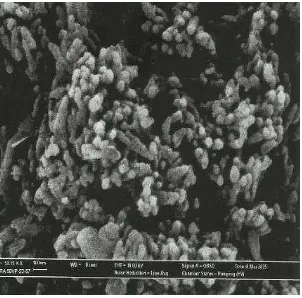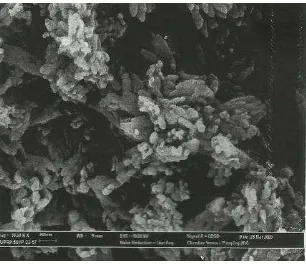INFLUENCE OF CALCIUM HYDROXIDE CONCENTRATION ON THE
SYNTHESIS NANOSIZED PRECIPITATED CALCIUM CARBONATE
Nooririnah,O
1, a,
Muhamad Azwar,A
2,b,Yusliza,Y
1,c, Umar Al-amani, A
1,d,
Mohd Faiz, W
1,e, Zuraidah, RR
3,f, Suhana,M
4,g, Rohana,S
4,h,
1
Department of Manufacturing Engineering Technology, Faculty of Engineering Technology,
University Teknikal Malaysia Melaka, 76100, Durian Tunggal, Melaka, Malaysia. 2
Department of Mechanical Engineering Technology, Faculty of Engineering Technology,
University Teknikal Malaysia Melaka, 76100, Durian Tunggal, Melaka, Malaysia 3
Faculty of technology management and business, University Tun Hussein Onn Malaysia,
Batu pahat,Johor,Malaysia 4
Faculty of business management, University Teknologi Mara, kampus johor bharu, Jln Heman, Kg.Aman, Larkin,Johor Bharu,Malaysia a
[email protected], [email protected], [email protected], d [email protected], e
[email protected], [email protected] , [email protected], h
Keywords: synthesis PCC; effect Ca(OH)2; MOL
Abstract- The precipitated of calcium carbonate has attracted much attention because of its numerous applications in various areas of plastics, textiles, rubbers, adhesives, paints and waste water treatment. Nanosized of precipitated calcium carbonate, (PCC) will enhance the properties and give better performance. Its high purity and close controlled particle size and shape are making it the white filler of choice. Nanosized precipitated calcium carbonate particles were prepared using spraying method. The particles were prepared using three (3) different concentrations of Calcium Hydroxide, Ca(OH)2, three (3)
CO2 flow rate and three (3) different calcinations
temperatures. The three (3) concentration of Calcium Hydroxide that been used are 25g / 200ml, 25g / 400ml and 25g / 800ml and each of these initial solution sprayed at Calcium Hydroxide, Ca(OH)2 was increased.
I.
INTRODUCTION
distribution and specific surface area [2].A ground calcium carbonate will normally have a rhombic morphology since this is the natural shape of calcite fragments. Rhombohedral PCC plays a role in paper filler but is of more interest as a coating PCC. The aragonite is used for special purpose, where more exotic properties in the paper are sought. The pseudo-amorphous PCC is really agglomerates of very fine calcite crystals. No practical use for these products is known but they are of interest to the PCC manufacturer since they tend to show up if control over the process is lost [2]. There are several precipitation techniques in which the precipitation of PCC is reported included modified emulsion membrane. The determination of the relationship between precipitation conditions and product morphology is still a major challenge in synthesis of precipitated calcium carbonate with super fine particle size. Control of crystal size and shape of precipitated calcium carbonate (PCC) is important for the subsequent separation process and quality of the product and takes on additional significance when scale up issues are involved[3]. Spray method is one of the alternative that can be used to control of crystal size and to produce small particle in size. Spray gun was used to produce mist milk of lime (MOL) and spray together at the same time but from different nozzle into a chamber. Factors that must be considered to achieve nanosized PCC are MOL must be in mist condition, Carbon dioxide flow rate and concentration of initial solution. It was observed at a low concentration of 25g/800ml, particle size of calcium carbonate tend to be smaller with decreasing concentration. Objective of this paper, to discuss effect of different initial concentration solution on synthesis nano sized precipitated calcium carbonate.
II. METHODOLOGY
Raw Materials. Calcium carbonate powders from Simpang Pulai, Perak used as source of calcium
carbonate particle, Distilled water, CO2, Merck-Shuchard Polyethylenglycol 1500
Preparation of Nano-Precipitated Calcium Carbonate involved 4 steps;
1) Calcination of calcium carbonate 2) Preparation of milk of lime (MOL) 3) Spraying MOL
4) Filter
1) Calcination of calcium carbonate
Calcium carbonate with weight of 200 gram will be places in furnace for 180 minutes with 3°C per minute and their upgrading for calcination process. This process will decompose calcium carbonate into calcium oxide. Reaction takes places is
CaCO2 (s) > 900°C CaO(s) + CO2 (g) (equation 2.1)
2) Preparation of milk of lime (MOL)
Calcium oxide dissolved in water to form calcium hydroxide in 500biker, mL for slaking process. Quantity distilled water vary from one sample to other, (200 ml, 400 ml, 800 ml). Hydrated-lime, Ca(OH)2 suspension was preheated at 55-60°C. This step to help better dissolved of Calcium oxide in distilled water, Polyethylenglycol 1500 (PEG) was added as stabilizer. Reaction takes place is
CaO (s) + H2O slaking Ca (OH)2 (equation 2.2)
3) Suspension milk of lime (MOL) is pouring into a spray gun container and supplied air compressor as a force to produce a mist. CO2 gas supplied at the same time but from different nozzle. Milk of lime is spray into a chamber from spray gun. Precipitation will occur slightly in front of air gun nozzle that produced mist of calcium hydroxide. Nozzle of CO2 is placed as close as possible to this area. All precipitated liquid will be collected in a chamber. Reaction takes place is
Ca (OH)2 (s) CO2 (g) CaCO3 (s) + H2O (equation 2.3) Precipitation
III. RESULT AND DISCUSSION
Table 1 show the particle size precipitated calcium carbonate at different concentration of initial solution. It was observed at a low concentration of 25g/ 800 ml, particle size of calcium carbonate tend to be smaller with decreasing concentration. The particle size decrease when the ionic strength of the Ca (OH)2 was decreased. One of the unique properties of using spray method is the compartmentalized environment bounded to the internal droplet by mist. The Ca2+ dwelled in one droplet, will not diffuse to another. Therefore, each droplet can taken as individual microreaction compartment containing limited Ca2+. The total mass of constituents involved in the reaction in the compartment can be controlled by the concentration present in the mother liquor. For the system adopted in the study, the quantity of Ca2+ in the internal water was controlled by the initial loading. Obviously, the reaction that occurred in situ will stopped automatically when the concentration of Ca2+ is lower than the solubility limitation of Ksp / [CO3 2- ] where Ksp is the equilibrium saturation solubility product of CaCO3 and is the equilibrium saturation concentration of CO32-. Theoretically, if the volume of a droplet and the number of PCC particles possibly formed in it are known, the particle size of PCC can be calculated simply by the following equation ( presuming the particles is in a spherical shape and the internal Ca2+ ions are completely consumed)
r = MiR (CIN / 1000np ) 1/3
Where r and R denote the radius of PCC particles and droplets, respectively; Mi is the molecular weight of CaCO3; CIN is the feeding concentration of Ca2+ (mol/l); n denotes the average number of PCC particles produced within one droplet and p is the density of the PCC ( 2.93 g/cm3) . With the decreased of CIN , the particle size decreased steadily because lack of Ca2+ ions in each droplet to react with CO32- ions and will retard crystallization growth.
Table 1: Particle size precipitated calcium carbonate at different concentration of initial solution Initial
concentration/ CO2 flow rate
25 gram / 200ml ( 2.25M)
25gram / 400ml ( 1.13M)
25gram / 800ml ( 0.56M)
5Liter / minute 127nm 274nm 82nm
7 Liter / minute 206nm 158nm 160nm
10 Liter / minute 206nm 120nm 121nm
Figure 1: Effect of various lime concentration on the particle size of precipitated calcium carbonate, PCC
Figure 2: 25g / 200ml, 5L CO2, 1100°C, (x30000)
Figure 4: 25g / 400ml, 5L CO2, 1100°C, (x30000)
Figure 5: 25g / 400ml, 5L CO2, 1100°C, (x50000)
Figure 6: 25g / 800ml, 5L CO2, 1100°C, (x30000) Figure 7: 25g/800ml, 5L CO2, 1100°C, (x50000)
Figure 7: 25g / 800ml, 5L CO2, 1100°C, (x50000)
Figure 1 - figure 7 shows the Scanning electron microscope (SEM) images of the precipitated calcium carbonate particle of different concentration. It was observed that at a low concentration of 25g/800ml, calcium carbonate particles formed like cubic rhombohedral crystals and with increasing concentration to 25g / 400ml, either short or long structured prismatic shapes, scalenohedron was produced. The morphology of particles changed to spindle like or prismatic when the ionic strength of the Ca (OH)2 was increased.
Attributed the yield and growth of spindle or prism like crystals to the excess Ca2+ ions in the reaction solution. In the actual precipitation process, dissolution of CO2 into the chamber is slow so the actual volume of CO2 adsorbed is lower than the ideal stoichiometric reaction of calcium carbonate. This results in an access of Ca2+ ions in the solution which appear to be adsorbed on the preferred face of cubic like calcium carbonate particles. Then the adsorbed ions inhibit the face growth of a particle and produce modifications in particle morphology to spindle, prism or tabular like crystal.
Figure 8: Variation in particle morphology with the concentration of initial solution [2]
IV. CONCLUSION
REFERENCES
[1]Hochella,Jr. and Michael,F. Nanoscience and technology the next revolution in the earth science, Earth and planetary science letters 203, ( 2002), pp. 593-605
[2] Ariffin, K.S. Effects of operating variables on precipitated calcium carbonate (PCC), RAMM conference (2001), pp 68-80.
[3]Bates,L. P., Harrison, D. L.; Precipitated Calcium Carbonate Fillers in Low Modulus Thixotropic Sealants; Adhesives, Sealants and Encapsulants Conference -
[5] Chen, Le-Shang, Mai, Yiu-Wing, Cotterell, Brian, Impact fracture energy of mineral-filled polypropylene, PolymEngSci v 29 n 8,( 1989), p 505-512.
[6] Kovacevic, V., Lucic, S., Leskovac, M., Morphology and failure in nanocomposites. Part I: Structural and mechanical properties, J AdhesSciTechnol v 16 n 10, (2002), p 1343-1365.
[7] Lee, I., Sang Woo Han, Hyouk Jin Choi, Kim, K., Nanoparticle-directed crystallization of calcium carbonate, Adv Mater v 21,(2001).
[8] Wang,L.ZCharacterization of nanophase materials, Wiley-VCH, (200), pp.1-4,13-17,37-40.
[9] Sun,Qunhui,Deng,Yulin, Synthesis of micrometer to nanometer CaCO3 particles via mass restriction method in an emulsion liquid membrane process, Journal of colloid and interface science, (2004), pp.376-382.
[10] Pokrovsky, S.O, Precipitation of calcium and
magnesium carbonates from homogeneous
supersaturated solutions, (1998), pp.233-239.
[11] Buchmeiser, R.Michael, Polymeric materials in organic synthesis and catalysis, Wiley-VCH, (2003), pp. 245-247.
[12] Andreassen, Petter-jens, Formation mechanism and morphology in precipitation of vateritenano aggregation or crystal growth?, submitted to Journal of crystal growth, (2004)
[13] Edelsten, A.S and cammarata, R.C, Nnaomaterials: synthesis,properties and applications, The institute of physics, (1996), pp.13-16,55-59.
[14] Hartwig,W.,Hanko,R. and Nicolaou K.C, Handbook of combination chemistry, Wiley-VCH, (2003), pp 44-45.
[15] Poharb, C., Kneza,S. The magnetic field influence on the polymorph composition of CaCO3 precipitated from carbonized aqueous solutions, submitted to Journal of colloid and interface science, (2004).
[16] Szczes, A., Chibowski, E and Holysz, L, Influence of impurity ions and magnetic field on the properties of freshly precipitated calcium carbonate, Water research, (2003), pp.3351-3360.
[17] O.Nooririnah, A.R.,Jeefferie , M.Y.Yuhazri, M.M.Haidir , A.R.Toibah , H.Sihombing , A.Azizan, Proceeding Effect of CO2 Flow Rate and Calcination Temperature on the Synthesis Nanosized Precipitated Calcium Carbonate, submitted to Workshop on advanced material science and nanotechnology, (2010)

